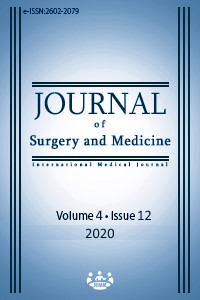Prognostic value of the Selvester QRS score for re-hospitalization in patients with ischemic heart failure
Keywords:
Heart failure, Re-hospitalization,, The Selvester QRS ScoreAbstract
Aim: The Selvester QRS score (SSc) on surface electrocardiogram (ECG) has prognostic value in various cardiac events related to myocardial scarring. Furthermore, the SSc system has been validated by post-mortem studies. In this cohort, we assessed the utility of the SSc system for prediction of re-hospitalization in patients with ischemic heart failure (HF). Methods: In this retrospective cohort study, the data of fifty-four consecutive patients with ischemic HF were analyzed. ECGs were collected at first day of admission and SScs were calculated. The primary endpoint was re-hospitalization within the first 3 months. Results: At baseline, the mean age was 62.1 years, LVEF was 29(6) %, NT-proBNP level was 2830 pg/mL. Twenty-one re-hospitalizations were observed due to HF. Patients who were re-hospitalized had significantly higher SScs than those who were not (5.6 vs.3.3 P= 0.01). Cox regression analysis demonstrated that the SSc was an independent predictor of re-hospitalization rate (HR, 1.12; 95% CI, 0.95–1.34; P=0.04). Roc curve analysis showed that SSc was predictive for rehospitalization with a cut-off value 4.3, with a sensitivity of 65% and a specificity of 49% (AUC 0.618, P=0.02). Our analysis indicated a positive correlation between SSc with NT-proBNP and a negative correlation between SSc and LVEF (respectively r=0.33, P=0.03 and r =-0.67, P=0.04). Conclusion: Our results suggest that baseline SSc can be used as a predictor of re-hospitalization due to ischemic HF.
Downloads
References
Castelvecchio S, Pappalardo OA, Menicanti L. Myocardial reconstruction in ischaemic cardiomyopathy. Eur J Cardiothorac Surg. 2019 Jun 1;55(Suppl 1):i49-i56. doi: 10.1093/ejcts/ezy367. PMID: 31106339; PMCID: PMC6526097.
Rossignol P, Hernandez AF, Solomon SD, Zannad F. Heart failure drug treatment. Lancet. 2019 Mar 9;393(10175):1034-44. doi: 10.1016/S0140-6736(18)31808-7. PMID: 30860029.
Matusik PS, Bryll A, Matusik PT, Popiela TJ. Ischemic and non-ischemic patterns of late gadolinium enhancement in heart failure with reduced ejection fraction. Cardiol J. 2020 Feb 10. doi: 10.5603/CJ.a2020.0009. Epub ahead of print. PMID: 32037500.
Markendorf S, Benz DC, Messerli M, Grossmann M, Giannopoulos AA, Patriki D, et al. Value of 12-lead electrocardiogram to predict myocardial scar on FDG PET in heart failure patients. J Nucl Cardiol. 2019 Aug 9. doi: 10.1007/s12350-019-01841-6. Epub ahead of print. PMID: 31399902.
Selvester RH, Wagner GS, Hindman NB. The Selvester QRS scoring system for estimating myocardial infarct size: the development and application of the system. Archives of Internal Medicine. 1985;145(10):1877-81.
Wagner GS, Freye CJ, Palmeri ST, Roark SF, Stack NC, Ideker RE, et al. Evaluation of a QRS scoring system for estimating myocardial infarct size. I. Specificity and observer agreement. Circulation. 1982;65(2):342-7.
Tiller C, Reindl M, Reinstadler SJ, Holzknecht M, Schreinlechner M, Peherstorfer A, et al. Complete versus simplified Selvester QRS score for infarct severity assessment in ST-elevation myocardial infarction. BMC Cardiovascular Disorders. 2019;19(1):1-7.
Bignoto TC, Le Bihan D, de Mattos Barretto RB, de Oliveira Ramos AI, Moreira DAR, Simonato M, et al. Predictive role of Selvester QRS score in patients undergoing transcatheter aortic valve replacement. Catheter Cardiovasc Interv. 2020 Apr 16. doi: 10.1002/ccd.28905.
Hiraiwa H, Okumura T, Sawamura A, Sugiura Y, Kondo T, Watanabe N, et al. The Selvester QRS score as a predictor of cardiac events in nonischemic dilated cardiomyopathy. Journal of Cardiology. 2018;71(3):284-90.
Ponikowski P, Voors AA, Anker SD, Bueno H, Cleland JG, Coats A, et al. 2016 ESC Guidelines for the diagnosis and treatment of acute and chronic heart failure: The Task Force for the diagnosis and treatment of acute and chronic heart failure of the European Society of Cardiology (ESC) Developed with the special contribution of the Heart Failure Association (HFA) of the ESC. European heart journal. 2016;37(27):2129-200.
Gouda P, Brown P, Rowe BH, McAlister FA, Ezekowitz JA. Insights into the importance of the electrocardiogram in patients with acute heart failure. European Journal of Heart Failure. 2016;18(8):1032-40.
Strauss DG, Selvester RH, Lima JA, Arheden H, Miller JM, Gerstenblith G, et al. ECG quantification of myocardial scar in cardiomyopathy patients with or without conduction defects: correlation with cardiac magnetic resonance and arrhythmogenesis. Circulation: Arrhythmia and Electrophysiology. 2008;1(5):327-36.
Hiraiwa H, Okumura T, Sawamura A, Sugiura Y, Kondo T, Watanabe N, et al. The Selvester QRS score as a predictor of cardiac events in nonischemic dilated cardiomyopathy. Journal of Cardiology. 2018;71(3):284-90.
Wieslander B, Loring Z, Zareba W, McNitt S, Wagner GS, Daubert JP, et al. Scar burden assessed by Selvester QRS score predicts prognosis, not CRT clinical benefit in preventing heart failure event and death: A MADIT-CRT sub-study. Journal of Electrocardiology. 2016;49(4):603-9.
Strauss DG, Poole JE, Wagner GS, Selvester RH, Miller JM, Anderson J, et al. An ECG index of myocardial scar enhances prediction of defibrillator shocks: an analysis of the Sudden Cardiac Death in Heart Failure Trial. Heart Rhythm. 2011;8(1):38-45.
Downloads
- 455 589
Published
Issue
Section
How to Cite
License
Copyright (c) 2020 Alper Karakuş, Berat Uğuz
This work is licensed under a Creative Commons Attribution-NonCommercial-NoDerivatives 4.0 International License.
















